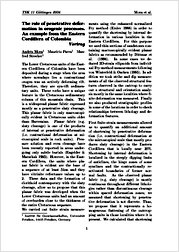The role of penetrative deformation in orogenic processes. An example from the Eastern Cordillera of Colombia
Mora, Andrés
Parra, Mauricio
Strecker, Manfred
Universitätsverlag Göttingen
Sammelband- / Konferenzbeitrag
Verlagsversion
Deutsch
Mora, Andrés; Parra, Mauricio; Strecker, Manfred, 2006: The role of penetrative deformation in orogenic processes. An example from the Eastern Cordillera of Colombia. In: Philipp, S.; Leiss, B; Vollbrecht, A.; Tanner, D.; Gudmundsson, A. (eds.): 11. Symposium "Tektonik, Struktur- und Kristallingeologie"; 2006, Univ.-Verl. Göttingen, p. 141 - 143., , DOI: 10.23689/fidgeo-1884.
 |
Dokument öffnen: |
The Lower Cretaceous units of the Eastern
Cordillera of Colombia have been
deposited during a stage when the area
where nowadays lies a contractional
orogen was an actively deforming rift.
Therefore, they are syn-rift sedimentary
units. These rocks have a unique
feature in the Cretaceous sedimentary
column of this mountain chain. This
is a widespread planar fabric expressed
mostly as a penetrative slaty cleavage.
This planar fabric is only macroscopically
evident in Cretaceous units older
than Barremian. Planar fabric (e.g.
slaty cleavage) is one of the products
of internal or penetrative deformation
(i.e. contractional deformation at microscopical
scale in rock units). Pressure
solution and even cleavage have
been recently reported in areas undergoing
only subtle burials (Engelder &
Marschak 1985). However, in the Eastern
Cordillera, the units where planar
fabric is evident are the base of
a sequence of at least 5km and they
have vitrinite reflectance values up to
2. These data and the formation of
clorithoid contemporary with the slaty
cleavage, allow us to propose that this
planar fabric was developed when the
Lower Cretaceous units had an amount
of overburden close to the thickness of
the entire Cretaceous sequence...

